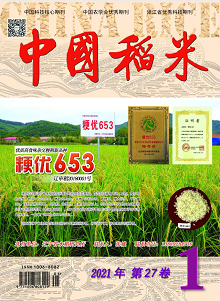The aims of this study were to identify the effects of silicon fertilizer applied at different stages on yield and quality of rice, and to provide theoretical basis and technical support for rational application of silicon fertilizer on japonica rice cultivar with good eating quality. The field experiment was conducted using good eating quality japonica rice Nangeng 9108 as material. Eight silicon fertilizer treatments were set up: seed soaking with silicon (T1), T1 plus 15 kg/hm2 silicon fertilizer applied by foliar spray at seedling stage (T2), T1 plus 15 kg/hm2 silicon fertilizer applied by foliar spray at jointing stage (T3), T1 plus 15 kg/hm2 silicon fertilizer applied by foliar spray at heading stage (T4), T1 plus 15 kg/hm2 silicon fertilizer applied by foliar spray at three stages (20% at seedling stage, 30% at jointing stage and 50% at heading stage)(T5), T1 plus 45 kg/hm2 silicon fertilizer applied by foliar spray at three stages (1/3 at seedling stage, 1/3 at jointing stage and 1/3 at heading stage) (T6). No fertilization (CK1) and conventional fertilization (CK2) were used as the control. The results showed that T6 treatment has the highest yield, followed by T5, T4, T3 treatment. The grain yield of T1 and T2 treatments increased slightly compared to CK2. The panicles number, spikelet number per panicle, 1000-grain weight and seed setting rate of the silicon fertilizer treatments were improved to different degrees than no silicon fertilizer treatments. The effects of silicon fertilizer on yield components was in order of spikelet number per panicle > panicle number > 1000-grain weight > seed setting rate. Under different silicon fertilizer treatments, the effects of T3, T5, T6 treatments on spikelet number per panicle and panicle number were larger than those of T1, T2 and T4 treatments. Compared with CK2, T3, T4, T5 and T6 treatments increased sink potential, source strength and source-sink ratio, and increased the brown rice percentage, milled rice percentage and head rice percentage. Meanwhile, the chalky rice rate, chalkiness degree and protein content were also decreased. Compared with CK2, T6 treatment significantly increased peak viscosity, hot viscosity, break down and cool viscosity, while these indexes were insignificantly affected by other treatments. The principal component analysis results showed that the effects of different silicon fertilizer treatments on rice yield and quality were in order of T6 > T5 > T4 > T3 > T2 > T1. Considering the silicon fertilizer input, yield and quality of rice, recommended silicon fertilizer application method for high-quality japonica rice was seed soaking with silicon plus spraying silicon fertilizer 15 kg/hm2 at three stages (20% at seedling stage, 30% at jointing stage and 50% at heading stage).

